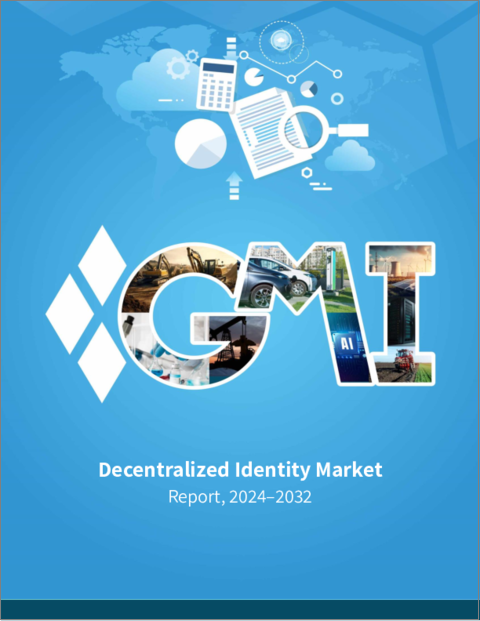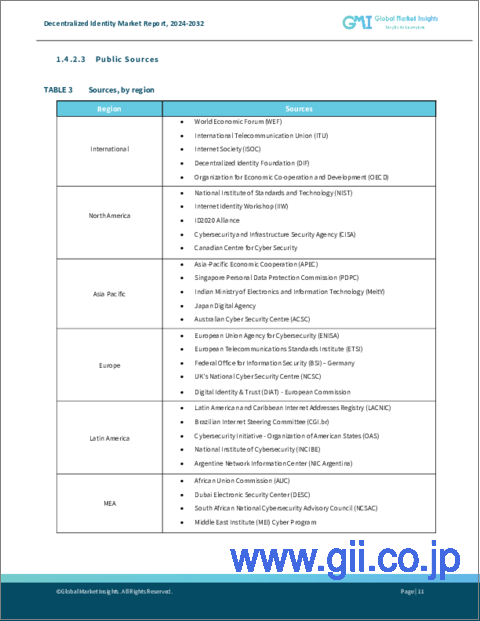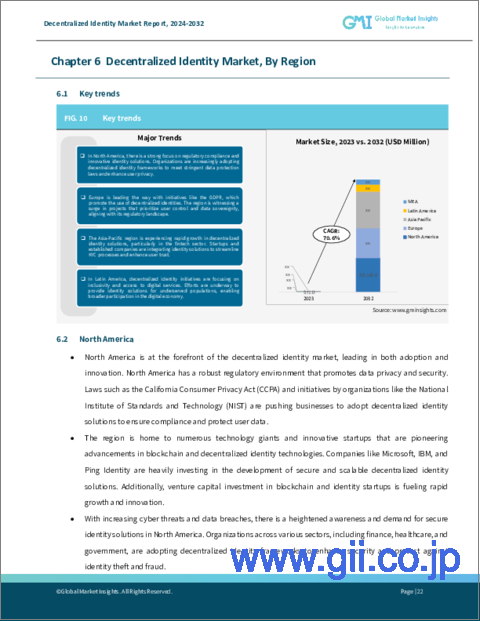|
|
市場調査レポート
商品コード
1544583
分散型ID市場、市場機会、成長促進要因、産業動向分析と予測、2024-2032年Decentralized Identity Market, Opportunity, Growth Drivers, Industry Trend Analysis and Forecast, 2024-2032 |
||||||
カスタマイズ可能
|
|||||||
| 分散型ID市場、市場機会、成長促進要因、産業動向分析と予測、2024-2032年 |
|
出版日: 2024年07月03日
発行: Global Market Insights Inc.
ページ情報: 英文 230 Pages
納期: 2~3営業日
|
全表示
- 概要
- 目次
分散型ID市場規模は、安全でユーザーが管理できるデジタルIDソリューションへの需要の高まりにより、2024年から2032年の間に70%以上のCAGRを記録すると予想されます。
従来のアイデンティティ・システムは、中央集権的なリポジトリに依存することが多く、侵害や悪用の影響を受けやすいです。対照的に、分散型ID技術は個人が個人情報を管理できるようにし、ID盗難のリスクを大幅に軽減してプライバシーを強化します。
増大する懸念に対応して、世界中の政府や組織は、個人データの保護とデータ取扱いの透明性の促進を目的とした厳格な規制を制定しています。分散型IDシステムは、安全で検証可能でプライバシーを重視したID管理を通じて、こうした規制の要請を満たすことに長けた、強力なソリューションとして台頭してきました。例えば2024年5月、MicroStrategy Orangeは分散型IDを発表し、その信頼性、改ざん防止、永続性を強調しました。企業が進化する規制基準に対応し、デジタル・セキュリティの強化に努める中、分散型ID市場はそれに対応する急成長を目の当たりにしています。
IDタイプ別に見ると、非バイオメトリクス・セグメントによる分散型ID市場規模は、2032年まで大幅な成長が続くと予測されます。この急成長は、暗号鍵、デジタル署名、多要素認証などの非バイオメトリクス・ソリューションに起因しており、これらは従来のバイオメトリクス方式を補完するだけでなく、セキュリティと柔軟性の追加レイヤーを導入します。これらの非バイオメトリクス方式は、分散型IDシステムに統合された場合、セキュリティを強化するだけでなく、バイオメトリクス・データに関連しがちなプライバシーの懸念にも対処します。
中小企業(SMEs)セグメントの分散型ID市場は、コスト効率が高く拡張可能で安全なID管理ソリューションの必要性から、2024年から2032年の間に高い収益を上げると予想されます。分散型IDシステムは、従来の集中型システムに伴う高コストをかけずにセキュリティを強化し、ID検証プロセスを合理化する方法を中小企業に提供します。
欧州の分散型ID業界は2032年まで力強い成長を遂げると予測されているが、その主な理由は厳しい規制状況とデジタル革新への揺るぎない取り組みにあります。一般データ保護規則(GDPR)は極めて重要な力として際立っており、個人データに対するユーザー管理の重要性を強調し、厳格なプライバシー保護を提唱することで、欧州における分散型IDソリューションの軌道を形成しています。
目次
第1章 調査手法と調査範囲
第2章 エグゼクティブサマリー
第3章 業界洞察
- エコシステム分析
- ベンダー・マトリックス
- 利益率分析
- テクノロジーとイノベーションの展望
- 特許分析
- 主要ニュースと取り組み
- 規制状況
- 影響要因
- 促進要因
- デジタルトランスフォーメーションへの取り組みの増加
- なりすましや詐欺事件の増加
- モノのインターネット(IoT)の出現
- 企業のデジタルIDニーズ
- 大手テクノロジー企業からの支援
- 業界の潜在的リスク&課題
- ユーザー・エクスペリエンス(UX)の問題
- レガシーシステムとの統合
- 促進要因
- 成長可能性分析
- ポーター分析
- PESTEL分析
第4章 競合情勢
- イントロダクション
- 企業シェア分析
- 競合のポジショニング・マトリックス
- 戦略展望マトリックス
第5章 市場推計・予測:IDタイプ別、2021年~2032年
- バイオメトリクス
- 非バイオメトリクス
第6章 市場推計・予測:企業規模別、2021年~2032年
- 大企業
- 中小企業
第7章 企業規模別市場推計・予測:業界別、2021年~2032年
- BFSI
- 小売・eコマース
- IT・通信
- 政府・公共部門
- ヘルスケア
- 不動産
- メディア・娯楽
- その他
第8章 市場推計・予測:地域別、2021年~2032年
- 主要動向
- 北米
- 米国
- カナダ
- 欧州
- 英国
- ドイツ
- フランス
- イタリア
- スペイン
- その他欧州
- アジア太平洋
- 中国
- インド
- 日本
- 韓国
- ニュージーランド
- その他アジア太平洋地域
- ラテンアメリカ
- ブラジル
- メキシコ
- その他ラテンアメリカ
- 中東・アフリカ
- UAE
- 南アフリカ
- サウジアラビア
- その他中東・アフリカ
第9章 企業プロファイル
- 1 Kosmos Inc.
- Accenture
- Affinidi
- Avast Software s.r.o.
- Civic Technologies, Inc.
- Datarella GmbH
- Dragonchain Inc.
- Evernym Inc.
- Finema Co., Ltd.
- Hu-manity.co
- Jolocom GmbH
- Kiva Protocol
- Microsoft
- Nuggets
- NuID Inc.
- Ontology
- Persistent Systems
- Ping Identity
- R3
- SecureKey Technologies Inc.
- SelfKey Foundation
- Serto Inc.
- Validated ID SL
- Veramo
- Wipro
Decentralized identity market size is expected to register over 70% CAGR between 2024 and 2032, driven by the rising demand for secure, user-controlled digital identity solutions. Conventional identity systems, often reliant on centralized repositories, are susceptible to breaches and misuse. In contrast, decentralized identity technology empowers individuals to retain control over their personal information, significantly mitigating the risks of identity theft and bolstering privacy.
In response to growing concerns, governments and organizations worldwide are enacting stringent regulations aimed at safeguarding personal data and promoting transparency in data handling. Decentralized identity systems have emerged as a formidable solution, adept at fulfilling these regulatory mandates through secure, verifiable, and privacy-centric identity management. For example, in May 2024, MicroStrategy Orange unveiled decentralized identities, emphasizing their trustless, tamper-proof, and enduring nature, all made possible by harnessing the Bitcoin blockchain. As enterprises strive to keep pace with evolving regulatory standards and bolster their digital security, the decentralized identity market witnesses a corresponding surge.
The overall industry is segmented into identity type, enterprise size, industry vertical, and region.
Based on identity type, the decentralized identity market size from the non-biometrics segment is projected to observe substantial growth through 2032. This surge is attributed to non-biometric solutions, such as cryptographic keys, digital signatures, and multi-factor authentication, which not only complement traditional biometric methods but also introduce added layers of security and flexibility. These non-biometric methods, when integrated into decentralized identity systems, not only bolster security but also address the privacy concerns often linked with biometric data.
Decentralized identity market from the small and medium-sized enterprises (SMEs) segment is anticipated to generate high revenue between 2024- 2032 due to the need for cost-effective, scalable, and secure identity management solutions. Decentralized identity systems offer SMEs a way to enhance security and streamline identity verification processes without the high costs associated with traditional centralized systems.
Europe decentralized identity industry is predicted to grow at a strong rate through 2032, largely credited to the stringent regulatory landscape and unwavering commitment to digital innovation. The General Data Protection Regulation (GDPR) stands out as a pivotal force, shaping the trajectory of decentralized identity solutions in Europe by underscoring the importance of user control over personal data and advocating for rigorous privacy protections.
Table of Contents
Chapter 1 Methodology and Scope
- 1.1 Market scope and definition
- 1.2 Base estimates and calculations
- 1.3 Forecast calculation
- 1.4 Data sources
- 1.4.1 Primary
- 1.4.2 Secondary
- 1.4.2.1 Paid sources
- 1.4.2.2 Public sources
Chapter 2 Executive Summary
- 2.1 Industry 360º synopsis, 2021 - 2032
Chapter 3 Industry Insights
- 3.1 Industry ecosystem analysis
- 3.2 Vendor matrix
- 3.3 Profit margin analysis
- 3.4 Technology and innovation landscape
- 3.5 Patent analysis
- 3.6 Key news and initiatives
- 3.7 Regulatory landscape
- 3.8 Impact forces
- 3.8.1 Growth drivers
- 3.8.1.1 Increased digital transformation initiatives
- 3.8.1.2 Rising incidents of identity theft and fraud
- 3.8.1.3 Emergence of the Internet of Things (IOT)
- 3.8.1.4 Corporate digital identity needs
- 3.8.1.5 Support from major technology companies
- 3.8.2 Industry pitfalls and challenges
- 3.8.2.1 User Experience (UX) issues
- 3.8.2.2 Integration with legacy systems
- 3.8.1 Growth drivers
- 3.9 Growth potential analysis
- 3.10 Porter's analysis
- 3.10.1 Supplier power
- 3.10.2 Buyer power
- 3.10.3 Threat of new entrants
- 3.10.4 Threat of substitutes
- 3.10.5 Industry rivalry
- 3.11 PESTEL analysis
Chapter 4 Competitive Landscape, 2023
- 4.1 Introduction
- 4.2 Company market share analysis
- 4.3 Competitive positioning matrix
- 4.4 Strategic outlook matrix
Chapter 5 Market Estimates and Forecast, By Identity Type, 2021 - 2032 (USD Billion)
- 5.1 Biometrics
- 5.2 Non-biometrics
Chapter 6 Market Estimates and Forecast, By Enterprise Size, 2021 - 2032 (USD Billion)
- 6.1 Large enterprises
- 6.2 Small and medium-sized enterprises
Chapter 7 Market Estimates and Forecast, By Industry Vertical, 2021 - 2032 (USD Billion)
- 7.1 BFSI
- 7.2 Retail and e-commerce
- 7.3 IT and telecommunication
- 7.4 Government and public sector
- 7.5 Healthcare
- 7.6 Real estate
- 7.7 Media and entertainment
- 7.8 Others
Chapter 8 Market Estimates and Forecast, By Region, 2021 - 2032 (USD Billion)
- 8.1 Key trends
- 8.2 North America
- 8.2.1 U.S.
- 8.2.2 Canada
- 8.3 Europe
- 8.3.1 UK
- 8.3.2 Germany
- 8.3.3 France
- 8.3.4 Italy
- 8.3.5 Spain
- 8.3.6 Rest of Europe
- 8.4 Asia Pacific
- 8.4.1 China
- 8.4.2 India
- 8.4.3 Japan
- 8.4.4 South Korea
- 8.4.5 ANZ
- 8.4.6 Rest of Asia Pacific
- 8.5 Latin America
- 8.5.1 Brazil
- 8.5.2 Mexico
- 8.5.3 Rest of Latin America
- 8.6 MEA
- 8.6.1 UAE
- 8.6.2 South Africa
- 8.6.3 Saudi Arabia
- 8.6.4 Rest of MEA
Chapter 9 Company Profiles
- 9.1. 1 Kosmos Inc.
- 9.2 Accenture
- 9.3 Affinidi
- 9.4 Avast Software s.r.o.
- 9.5 Civic Technologies, Inc.
- 9.6 Datarella GmbH
- 9.7 Dragonchain Inc.
- 9.8 Evernym Inc.
- 9.9 Finema Co., Ltd.
- 9.10 Hu-manity.co
- 9.11 Jolocom GmbH
- 9.12 Kiva Protocol
- 9.13 Microsoft
- 9.14 Nuggets
- 9.15 NuID Inc.
- 9.16 Ontology
- 9.17 Persistent Systems
- 9.18 Ping Identity
- 9.19 R3
- 9.20 SecureKey Technologies Inc.
- 9.21 SelfKey Foundation
- 9.22 Serto Inc.
- 9.23 Validated ID SL
- 9.24 Veramo
- 9.25 Wipro





